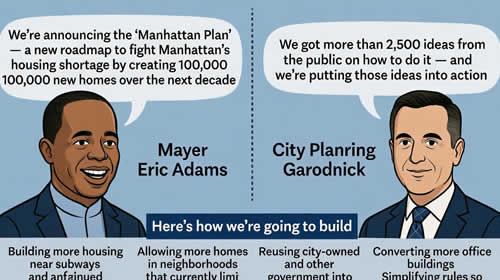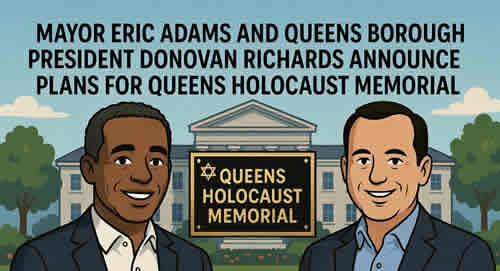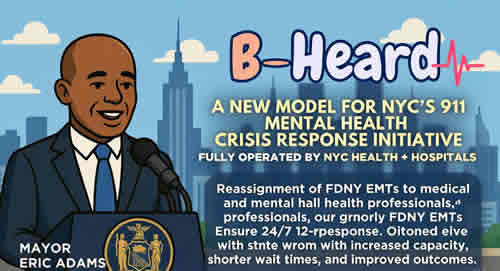New York City Mayor Eric Adams and Department of City Planning (DCP) Director Dan Garodnick released the “Manhattan Plan,” a borough-wide housing blueprint aimed at easing Manhattan’s severe housing shortage by adding 100,000 new homes over the next 10 years. Shaped by an extensive public engagement effort that generated more than 2,500 ideas, the plan focuses on building more housing near transit and job centers, enabling growth in areas that currently limit new development, redeveloping city- and government-owned sites, accelerating office-to-residential conversions, and streamlining regulations to cut red tape and speed delivery. The administration points to early momentum through actions such as the Midtown South Mixed-Use Plan (nearly 10,000 homes), the planned transformation of 100 Gold Street into a mixed-use tower with 3,700 apartments (at least 25% permanently affordable), and zoning changes to create nearly 700 homes above a future Second Avenue Subway station in East Harlem—framing the initiative as part of broader citywide efforts to expand housing supply and improve affordability.
Most Pro-Housing Administration in City History: Mayor Adams, City Planning Release “Manhattan Plan,” Ambitious Proposal to Build 100,000 New Homes in the Borough Over Next Decade
NEW YORK – New York City Mayor Eric Adams and New York City Department of City Planning (DCP) Director Dan Garodnick today released the “Manhattan Plan,” a bold blueprint to tackle Manhattan’s deep housing shortage by adding 100,000 new homes to the borough over the next decade. After an extensive public engagement process that collected more than 2,500 ideas for where and how to create new housing in Manhattan, the plan lays out key strategies for creating new housing in Manhattan, including adding more homes close to transit and in areas that restrict new housing, redeveloping city-owned sites, facilitating office-to-residential conversions, implementing regulatory improvements, and more. Since unveiling the Manhattan Plan in his State of the City address earlier this year, the Adams administration has already advanced several initiatives to create more housing in the borough, including passing the Midtown South Mixed-Use Plan to build nearly 10,000 more homes in the heart of Manhattan, the redevelopment of city-owned sites like 100 Gold Street in Lower Manhattan, and individual applications for zoning changes like the creation of nearly 700 homes above a future Second Avenue Subway station in East Harlem.
“For too long, the cost of living in Manhattan has gone up, working-class families have gone away, and our city’s housing crisis has grown more severe. Our administration promised to change that, advancing bold plans to bring thousands of new homes to the borough and make sure that Manhattan is still a place you can live and raise a family,” said Mayor Adams. “We passed the first citywide rezoning in six decades, landed the plane on our Midtown South Mixed-Use Plan, and with today’s announcement, are putting forward our ambitious ‘Manhattan Plan’ to bring 100,000 new homes to the borough. With the innovative ideas laid out here, we will help create the homes that Manhattan needs, deliver the more affordable future that all New Yorkers deserve, and reinforce, once again, our position as the most pro-housing administration in city history.”
“Between our five neighborhood plans, City of Yes, and now a first borough-wide plan, we have cemented our legacy as the most pro-housing administration in our city’s history.” said Deputy Mayor for Housing, Economic Development, and Workforce Adolfo Carrión, Jr. “I am very pleased to lay out this roadmap to unlock more housing in our most job- and transit-rich borough. I thank the visionary team at the Department of City Planning and Director Garodnick for their leadership in making Manhattan more accessible and affordable.”
“For generations, Manhattan was the place where people of all backgrounds could start their life’s journey and find new opportunities. This important plan lays out how it can fulfill that role once again,” said DCP Director Garodnick. “By embracing the ambitious, transformative ideas outlined in this framework, we can ensure that many more New Yorkers can live, work, and follow their dreams in a more affordable, welcoming, and vibrant Manhattan.”
Manhattan’s unparalleled job market, transit access, and walkability helped make the borough a site of enormous opportunity through the 20th century and drove a housing boom that unlocked all the island had to offer for millions of New Yorkers. But Manhattan’s housing production has dropped sharply when compared to the previous century. Today, Manhattan produces less housing than every other borough except for Staten Island; income-restricted affordable housing is also in extremely short supply.
Due to the lack of housing options, today, almost half of Manhattanites are rent-burdened, meaning they spend more than 30 percent of their income on rent, and about a quarter are severely rent-burdened, meaning they spend more than half of their income on rent. The Manhattan Plan looks to address this severe housing shortage through a set of strategies to help create 100,000 new homes over the next decade. Delivering these additional homes will allow more New Yorkers of all income levels to live near transit, jobs, schools, parks, and cultural resources — reaffirming Manhattan’s historic role as a place of opportunity. Ultimately, new housing will deliver a win-win-win: giving New Yorkers more affordable places to live, workers more opportunities to connect with nearby jobs, and small businesses more foot traffic.
The Manhattan Plan was developed through extensive public input gathered through pop-up events in every community district in the borough, online engagement, briefings, interviews, and focus groups held in English, Spanish, and Chinese. More than 2,500 ideas on where and how to bring new housing to Manhattan were generated from this public input process, including over 900 responses to the website survey and over 1,000 contributions to an interactive map.
The Manhattan Plan is built around six key themes that reflect the many ideas received for where and how the city can increase the borough’s housing supply:
- Housing near transportation and job centers: To take advantage of the borough’s role as the nation’s largest job center and one of its most significant transit hubs, the plan suggests bolstering housing opportunities near both resources, such as the recently-approved 125th Street and Lexington Avenue Project by the Metropolitan Transportation Authority, which will use “City of Yes’” new, high-density R11 zoning district to generate nearly 700 new homes, including around 170 permanently-affordable, income-restricted homes.
- Housing in areas with greater housing potential or low housing production: While much of Manhattan permits new housing, many mid-density areas have the capacity for additional housing and affordable housing through land use changes. There are also opportunities to map the city’s high-density R11 and R12 zoning districts, a key component of City of Yes that could create permanently affordable homes in some of the densest parts of the borough.
- Housing on city- or government-owned sites: The Manhattan Plan describes ideas for the increased use of government-owned sites for new housing, either as standalone developments or mixed-use projects with resources like schools or libraries on the ground floor. This work is already underway through projects like 100 Gold Street, an office building with several city agencies that will be transformed into a mixed-use tower with 3,700 apartments, at least a quarter of them permanently affordable.
- Housing on private sites: Although much of Manhattan is developed, there are opportunities for new housing on remaining vacant or underutilized private sites, such as those that are currently home to automotive uses, self-storage, parking lots, and more. The city will explore how to best incentivize the redevelopment of these sites for new housing, including through office-to-residential conversions.
- Improving the development process and regulatory environment: The Manhattan Plan explores ways to lessen regulatory barriers, cut red tape, get shovels in the ground, and help New Yorkers move into new homes faster. This work could include streamlined city agency processes, expedited financing, expanded funding streams, and other reforms.
- Expanding development models and building methods: From Housing Development Fund Corporation cooperatives to Mitchell-Lamas to Community Land Trusts, New York City has a long history of creative housing ownership and management models. This plan suggests ideas for expanding alternative ownership and development models for new housing.
When Mayor Adams came into office, he promised to turn the page on decades of dysfunction, make real progress against New York City’s long-standing housing crisis, and create 500,000 units of housing by 2032; four years later, he delivered, and the Adams administration is well on the way to that goal by creating, preserving, or planning over 433,000 homes through its efforts to date.
Thanks to decisive strategies to build more housing — including cutting red tape to speed up construction of new developments and investing a historic $26 billion towards affordable housing through the city’s 10-Year Capital Plan in Fiscal Year 2025 — the Adams administration has produced nearly 86,000 affordable homes, with the last three fiscal years representing the most new affordable homes ever created in a three fiscal-year stretch (Fiscal Year 2023 – Fiscal Year 2025).
The Adams administration also passed landmark changes to overhaul the city’s outdated zoning code and spark the creation of new housing. In December 2024, Mayor Adams passed “City of Yes for Housing Opportunity” — the most pro-housing legislation in city history — to create over 80,000 new homes and invest $5 billion in housing and infrastructure. Additionally, Mayor Adams passed five neighborhood plans to create nearly 50,000 homes over the next 15 years in the Bronx Metro North neighborhood, Central Brooklyn, Midtown South in Manhattan, and Long Island City and Jamaica in Queens. The Adams administration’s rezoning efforts in less than four years alone are expected to create more new housing than the previous two mayoral administrations’ rezoning efforts in 20 years combined.
To build new housing everywhere, Mayor Adams advanced over 10,000 new homes on city-owned land through his historic Executive Order 43; secured a landmark housing deal in Albany to give the city new housing tools; and convened the first-ever Charter Revision Commission to focus specifically on housing and land use measures.
Additionally, the Adams administration put public housing first, helping to unlock nearly $5.5 billion in capital repairs for over 24,000 residents through the Permanent Affordability Commitment Together program and helping establish the Preservation Trust to repair, rehabilitate, and modernize 25,000 apartments under control of the New York City Housing Authority.
Moreover, the Adams administration has worked to connect New Yorkers to homes and keep New Yorkers in their homes, connecting a record number 30,000 New Yorkers with affordable homes through the city’s Housing Lottery.
December 22, 2025
Sources: NYC.gov , Midtown Tribune news
Big New York news BigNY.com










